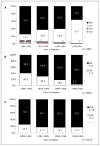The changing face of low-risk prostate cancer: trends in clinical presentation and primary management
- PMID: 15169800
- PMCID: PMC2997214
- DOI: 10.1200/JCO.2004.10.062
The changing face of low-risk prostate cancer: trends in clinical presentation and primary management
Abstract
Purpose: Early intervention for prostate cancer is associated with excellent long-term survival, but many affected men, especially those with low-risk disease characteristics, might not experience adverse impact to survival or quality of life were treatment deferred. We sought to characterize temporal trends in clinical presentation and primary disease management among patients with low-risk prostate cancer.
Methods: Data were abstracted from the Cancer of the Prostate Strategic Urologic Research Endeavor (CaPSURE), a disease registry of 8,685 men with various stages of prostate cancer. Included were 2,078 men who were diagnosed between 1989 and 2001 and had a serum prostate specific antigen </= 10 ng/mL, Gleason sum </= 6, and clinical T stage </= 2a. Trends in risk distribution, tumor characteristics, and primary treatment were evaluated.
Results: The proportion of patients with low-risk tumor characteristics rose from 29.8% in 1989 to 1992, to 45.3% in 1999 to 2001 (P <.0001). There have been sharp increases in the use of brachytherapy and androgen deprivation monotherapy, from 3.1% and 3.1%, to 12.0% and 21.7%, respectively. Utilization rates for prostatectomy, external-beam radiotherapy, and observation have fallen accordingly, from 63.8%, 16.1%, and 13.8%, to 51.6%, 6.8%, and 7.9% (P <.0001 for all except prostatectomy [P =.0019]). Age and socioeconomic status were significantly associated with treatment selection, but overall, the treatment trends were echoed on subgroup analysis of patients 75 years or older.
Conclusion: Low-risk features characterize a growing proportion of prostate cancer patients, and there have been significant shifts in the management of low-risk disease. Overtreatment may be a growing problem, especially among older patients.
Figures



References
-
- Jemal A, Murray T, Samuels A, et al. Cancer statistics, 2003. CA Cancer J Clin. 2003;53:5–26. - PubMed
-
- Quinlan DM, Partin AW, Walsh PC. Can aggressive prostatic carcinomas be identified and can their natural history be altered by treatment? Urology. 1995;46:77–82. - PubMed
-
- Steinberg GD, Bales GT, Brendler CB. An analysis of watchful waiting for clinically localized prostate cancer. J Urol. 1998;159:1431–1436. - PubMed
-
- Etzioni R, Penson DF, Legler JM, et al. Overdiagnosis due to prostate-specific antigen screening: lessons from U.S. prostate cancer incidence trends. J Natl Cancer Inst. 2002;94:981–990. - PubMed
-
- Han M, Partin AW, Zahurak M, et al. Biochemical (prostate specific antigen) recurrence probability following radical prostatectomy for clinically localized prostate cancer. J Urol. 2003;169:517–523. - PubMed
Publication types
MeSH terms
Substances
Grants and funding
LinkOut - more resources
Full Text Sources
Other Literature Sources
Medical

